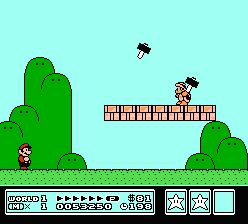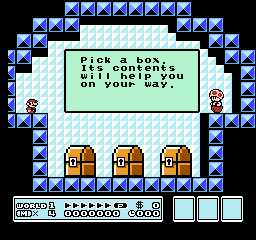World Maps[edit]

Each of the eight worlds in Super Mario Bros. 3 consists of a set of tiles which are connected via paths. The primary feature of each world are the regular stages, which are marked with a level number. While you are not required to complete each and every level in the game, you may not pass any tiles unless you have conquered that space on the map. For example, after you complete stage 2 in the first world, you may skip stages 3 and 4 entirely, but if you wish to visit the Mushroom House beyond them, you must complete at least one of those stages. Locks will exist on the map when you first arrive, but you can remove them by clearing one of the fortresses one the map. Although completed stages will need to be cleared again if you continue your game, the locks will remain open, providing you with a shortcut to the end of that world.
Along your journey, you will obtain power-up items which can be stored and utilized at a time of your choosing. These items can be retrieved by pressing ![]() while you are on the map screen. You will be presented with the first row of your inventory. Each row holds seven items, and you can fill up to four rows, for a total of 28 items. Any item that you collect beyond 28 will simply replace the 28th item, so be careful. After highlighting an item that you wish to use, press
while you are on the map screen. You will be presented with the first row of your inventory. Each row holds seven items, and you can fill up to four rows, for a total of 28 items. Any item that you collect beyond 28 will simply replace the 28th item, so be careful. After highlighting an item that you wish to use, press ![]() to activate the item before you enter a stage.
to activate the item before you enter a stage.
The following is a list of the most common map tiles that you are likely to encounter throughout the game, though you will find countless others as you explore each world.
| Tile | Description |
|---|---|
 |
This is one example of a typical stage tile. The number on the tile indicates which stage you are about to enter, and the number can be as high as 10 in some worlds. While you're often not required to complete every stage in a world, it's not a bad idea to at least explore each of them and get an idea of what they contain. You cannot pass a stage tile until it has been completed. |
 |
A completed tile on the map is signified by a large letter, representing the player who completed it. If player 1 completed a tile, it is replaced by a large red "M" for Mario. On the other hand, if player 2 completes the tile, it is replaced by a large green "L" for Luigi. |
 |
Fortresses are a special kind of stage. In addition to exploring an indoor space, you may typically encounter enemies which are unique to fortresses. These stages always end in a confrontation with the mini-boss known as Boom-Boom. Each fortress is associated with a lock somewhere on the map. |
 |
Locks prevent you from accessing sections of the map that can typically be used to bypass certain stages. Once a fortress has been conquered, the lock associated with that fortress will be removed. If you are ever lose all of your lives and are required to continue your game, any completed stages will be restored, but locks do not return, so you won't be forced to repeat every level. |
 |
 |
 |
Pipes on the map become increasingly common as you reach new worlds. By entering one, you will be transported into a tunnel that takes you to another location on the map. However, you can't always take advantage of these shortcuts until you have defeated a fortress, or possibly destroyed a rock with a hammer. |
 |
On very rare occasions, you may spot a rock right in the middle of a path. There's very little that you can do about it unless you happen to have a Hammer in your inventory. Then you can use the Hammer and smash the rock out of your way. Be selective, however, as Hammers are rare items. You may even be able to smash rocks that don't appear to be in the way of anything at all, only to reveal secrets that you weren't even aware of. |
 |
 |
 |
The White Mushroom House is a special house that you must reveal by performing particularly well on one stage. Each world, except for the 8th, has one stage where you must collect as many coins as possible. If you gather or exceed the required number of coins on that stage, the white house will appear. Inside you can obtain one particular item; P-Wings in odd worlds, and Anchors in even worlds. |
 |
 |
 |
 |